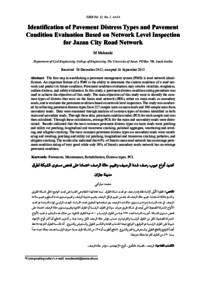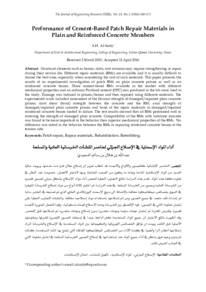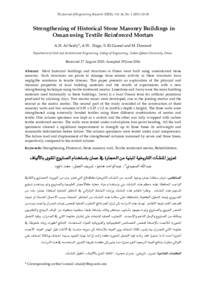وثيقة
Identification of pavement distress types and pavement condition evaluation based on network level inspection for Jazan city road network.
الناشر
Sultan Qaboos University
ميلادي
2014
اللغة
الأنجليزية
الملخص الإنجليزي
The first step in establishing a pavement management system (PMS) is road network identification. An important feature of a PMS is the ability to determine the current condition of a road network and predict its future condition. Pavement condition evaluation may involve structure, roughness, surface distress, and safety evaluation. In this study, a pavement distress condition rating procedure was used to achieve the objectives of this study. The main objectives of this study were to identify the common types of distress that exist on the Jazan road network (JRN), either on main roads or secondary roads, and to evaluate the pavement condition based on network level inspection. The study was conducted by collecting pavement distress types from 227 sample units on main roads and 500 sample units from secondary roads. Data were examined through analysis of common types of distress identified in both main and secondary roads. Through these data, pavement condition index (PCI) for each sample unit was then calculated. Through these calculations, average PCIs for the main and secondary roads were determined. Results indicated that the most common pavement distress types on main roads were patching and utility cut patching, longitudinal and transverse cracking, polished aggregate, weathering and raveling, and alligator cracking. The most common pavement distress types on secondary roads were weathering and raveling, patching and utility cut patching, longitudinal and transverse cracking, potholes, and alligator cracking. The results also indicated that 65% of Jazan's main road network has an average pavement condition rating of very good while only 30% of Jazan's secondary roads network has an average pavement condition.
المجموعة
ISSN
1726-6742
URL المصدر
zcustom_txt_2
Mubaraki, M. (2014). Identification of pavement distress types and pavement condition evaluation based on network level inspection for Jazan city road network. The Journal of Engineering Research, 11 (1), 44-54.
الملخص العربي
الخطوة الأولى لإنشاء نظام إدارة رصف هو تحديد شبكة الطرق. سمة هامة لهذا النظام هي القدرة على تحديد الوضع الحالي لشبكة الطريق والتنبؤ بالحالة المستقبلية. تقييم حالة الرصف قد يتضمن تقييم هيكل الرصف وتقييم خشونة الرصف وتقييم مستوى شدة السطح وتقييم سلامة الرصف. في هذه الدراسة إجراءات مستوى حالة شدة الرصف يتم استخدامها لتحقيق هدف الدراسة. الهدف الرئيسي لهذه الدراسة هو تحديد الأنواع المشتركة للضغوط التي توجد في شبكة طريق جيزان سواء في الطرق الرئيسية أو الطرق الثانوية وتقييم مستوى حالة الرصف اعتمادا على فحص مستوى الشبكة. أجريت الدراسة لعدد 227 عينة من الطرق الرئيسية و500 عينة للطرق الثانوية. من خلال هذه البيانات تم تحديد الأنواع المشتركة للضغوط لكل من الطرق الرئيسية والفرعية وتم حساب مؤشر حالة الرصف لكل وحدة عينة. و أشارت النتائج أن أكثر أنواع الإجهاد شیوعا على الطرق الرئيسية هو الترقيع والترقيع نتيجة الخدمات العامة والتكسير الطولي والمستعرض والشروخ. أما بالنسبة للطرق الفرعية نلاحظ أيضا الترقيع والقطع الطولي والمستعرض والحفر والشروخ. النتائج أظهرت أن 65% من الشبكة طرق مدينة جيزان الرئيسية تصنف بحالة جيدة جدا بينما 30% من الطرق الفرعية بحالة متوسطة.
قالب العنصر
مقالات الدوريات



